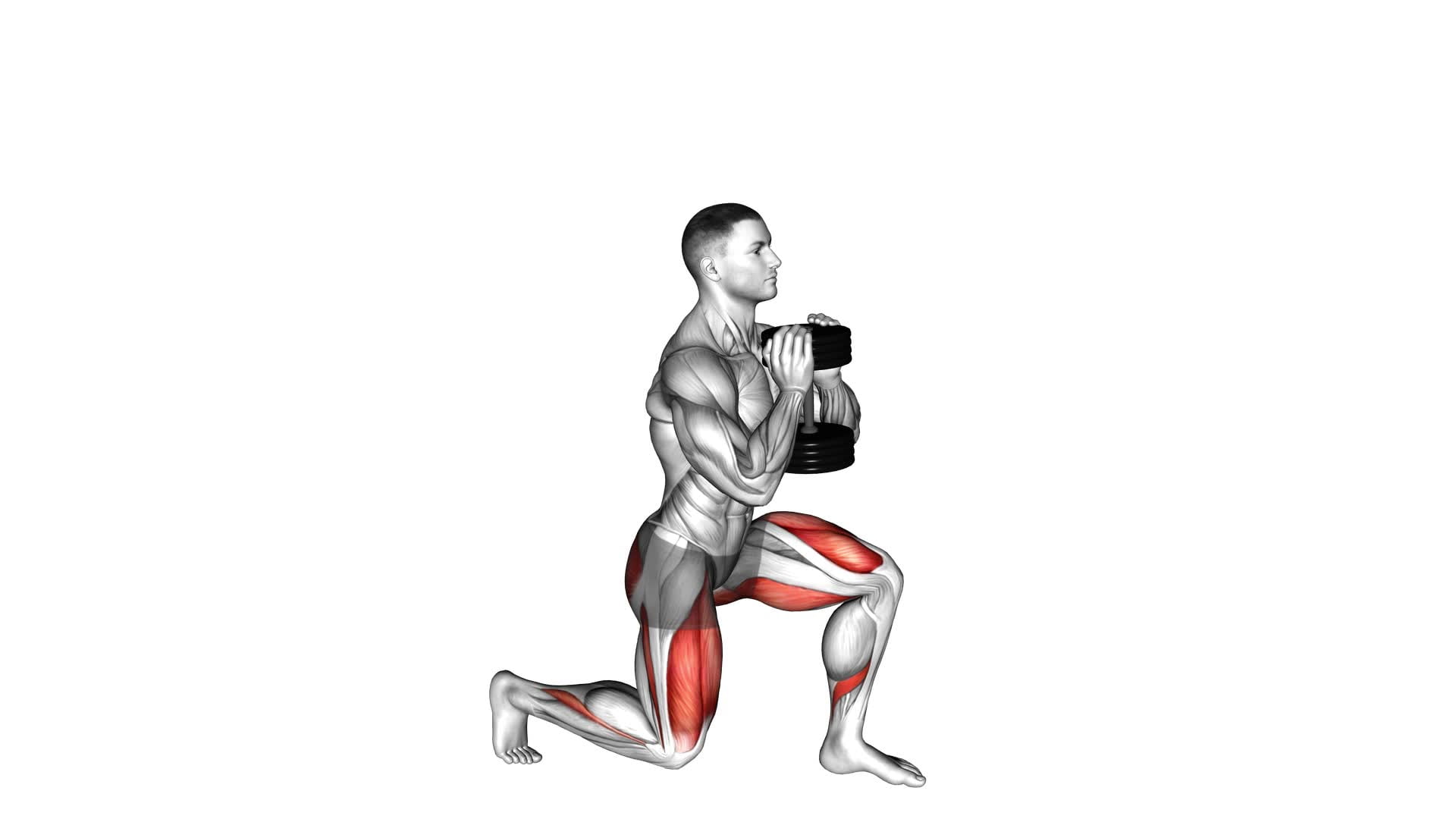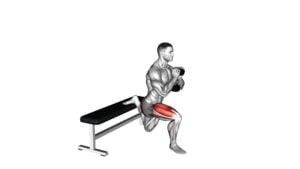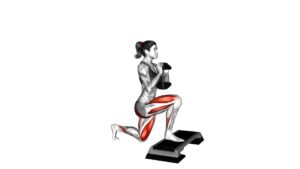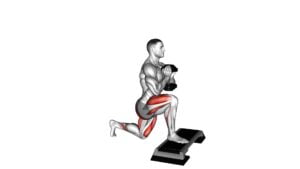Dumbbell Goblet Split Squat – Video Exercise Guide & Tips

Looking to strengthen your lower body? The dumbbell goblet split squat is a fantastic exercise to add to your routine.
Watch This Exercise Video
In this video guide, we'll show you the proper form and technique, as well as variations for different fitness levels.
Avoid common mistakes, increase intensity, and ensure safety with our tips and modifications.
Get ready to take your leg workout to the next level with this effective and challenging exercise.
Let's get started!
Key Takeaways
- Hold the dumbbell vertically against your chest with your elbows tucked in
- Prioritize proper form and technique over the amount of weight you lift
- Maintain an upright posture and engage your core muscles throughout the exercise
- Modify the exercise if you're a beginner by using lighter weights or body weight
Proper Form and Technique
To perform the Dumbbell Goblet Split Squat with proper form and technique, follow these steps:
- Hold the dumbbell in your hand.
- Set up your stance in a split position, with one foot forward and the other foot positioned behind you.
- Keep your feet hip-width apart for balance and stability.
- Hold the dumbbell vertically against your chest, with your elbows tucked in.
- Engage your core muscles and maintain an upright posture throughout the exercise.
To increase the intensity of the Dumbbell Goblet Split Squat, try these methods:
- Adjust the weight of the dumbbell, gradually increasing it as you get stronger.
- Perform the exercise at a slower tempo.
- Incorporate pauses at the bottom of the movement to increase time under tension.
Always prioritize proper form and technique over the amount of weight you lift. Focus on maintaining a controlled and stable position, and listen to your body's limits. By following these guidelines, you can perform the Dumbbell Goblet Split Squat with proper form and technique while gradually increasing the intensity for optimal results.
Setting Up for Success
To set yourself up for success with the Dumbbell Goblet Split Squat, there are a few key points to keep in mind.
First, make sure you have the proper form by keeping your chest up, shoulders back, and core engaged throughout the exercise.
Second, gather the necessary equipment, which includes a dumbbell and a stable surface to stand on.
Finally, be aware of common mistakes to avoid, such as leaning too far forward or allowing your knee to extend past your toes.
Proper Form Tips
Ensure proper form and set yourself up for success with the Dumbbell Goblet Split Squat. Proper technique is essential for maximizing the benefits of this exercise.
Start by standing with one foot forward and the other behind you, toes pointing forward. Hold a dumbbell vertically against your chest, close to your body.
As you lower your body into a lunge position, make sure your front knee stays directly above your ankle and doesn't go past your toes. Your back knee should bend, almost touching the ground. Keep your torso upright and engage your core for stability.
Push through your front heel to return to the starting position.
Transitioning into the next section, let's talk about the equipment needed for this exercise.
Equipment Needed
To set yourself up for success with the Dumbbell Goblet Split Squat exercise, you'll need the proper equipment. Here are the essentials:
- Dumbbells: Choose a weight that challenges you but allows you to maintain proper form throughout the exercise.
- Bench or Step: This will serve as your support for the rear leg during the split squat.
- Exercise Mat: Provides cushioning and stability for your feet during the exercise.
- Water Bottle: Staying hydrated is important during any workout, so make sure to have a water bottle nearby.
- Towel: Keep a towel handy to wipe off any sweat and stay comfortable during your workout.
Having the right equipment is crucial for performing the Dumbbell Goblet Split Squat effectively and safely. Whether you're a beginner or advanced, having these items will help you get the most out of your workout.
Common Mistakes to Avoid
Avoid these three common mistakes to set yourself up for success with the Dumbbell Goblet Split Squat exercise.
First, make sure to maintain proper form throughout the movement. One common mistake is allowing the front knee to cave inward, which can put unnecessary strain on the knee joint. Instead, focus on keeping the knee aligned with the toes.
Second, avoid leaning too far forward or backward. This can compromise your balance and stability, making the exercise less effective. Find a comfortable position where your torso stays upright throughout the movement.
Lastly, don't forget to modify the exercise if you're a beginner. Start by using lighter weights or even just your body weight until you feel comfortable and confident with the movement.
By avoiding these common mistakes and making necessary modifications, you'll be able to perform the Dumbbell Goblet Split Squat exercise safely and effectively.
Now, let's move on to the next section, which will discuss variations for different fitness levels.
Variations for Different Fitness Levels
Now let's talk about variations for different fitness levels. Whether you're a beginner or an advanced exerciser, there are modifications and adaptations that can be made to the dumbbell goblet split squat to suit your needs.
Beginners can start with lighter weights or even bodyweight, focusing on proper form and gradually increasing intensity.
Advanced individuals can challenge themselves by adding more weight or incorporating additional movements.
Beginner Modifications
Start by selecting a dumbbell weight that challenges you but allows you to maintain proper form throughout the exercise.
As a beginner, it's important to modify the Dumbbell Goblet Split Squat to suit your fitness level and avoid injury. Here are some beginner modifications and safety precautions to keep in mind:
- Use a lighter dumbbell or no weight at all until you build strength and stability.
- Start with a shorter range of motion by not going as low in the squat position.
- Keep your front foot closer to the rear foot for better balance.
- Use a support or hold onto a wall for added stability.
- Focus on maintaining proper form and engaging your core throughout the exercise.
Advanced Adaptations
To progress and continue challenging yourself in the Dumbbell Goblet Split Squat exercise, there are various advanced adaptations available for different fitness levels.
These advanced modifications and techniques allow you to take your workout to the next level and target specific muscle groups more intensely.
One advanced modification is to increase the weight of the dumbbell you're holding during the exercise. This will add more resistance and require your muscles to work harder.
Another advanced technique is to perform the exercise on an unstable surface, such as a Bosu ball or a balance board. This will engage your core muscles even more as they work to stabilize your body.
Additionally, you can incorporate plyometric movements into the exercise by adding a jump at the end of each repetition. This explosive movement will further challenge your lower body strength and power.
Customizing for Individual Needs
Customize the Dumbbell Goblet Split Squat exercise to meet your individual needs and fitness level by incorporating variations that target specific muscle groups. Whether you have a previous injury or a different body type, there are ways to adapt this exercise to suit you. Here are some ideas to consider:
- Customizing for Injuries: If you have knee issues, try performing the split squat with your back foot elevated on a step or bench to reduce pressure on the knee joint. Alternatively, you can use a resistance band to assist with balance and stability.
- Adapting for Different Body Types: Shorter individuals may find it helpful to place their front foot on an elevated surface to achieve a greater range of motion. Taller individuals, on the other hand, may need to widen their stance to maintain stability.
- Varying Dumbbell Weight: Adjusting the weight of the dumbbell can make the exercise more challenging or easier depending on your fitness level. Start with a weight that allows you to perform the exercise with proper form and gradually increase as you become stronger.
- Modifying Repetitions: Beginners can start with fewer repetitions and gradually increase over time. Advanced individuals can add more repetitions or incorporate tempo variations to increase the intensity.
- Experimenting with Foot Placement: Play around with different foot positions such as a narrow or wide stance to target different muscles, like the quads or glutes.
Common Mistakes to Avoid
Begin by ensuring that you don't let your front knee extend past your toes during the dumbbell goblet split squat exercise. This is a common mistake that many people make, especially beginners. Allowing your front knee to go past your toes can put unnecessary strain on your knee joint and increase the risk of injury.
To avoid this mistake, focus on keeping your weight on your front heel and pushing your hips back as you lower into the squat. This will help you maintain proper form and prevent your front knee from going too far forward. Additionally, make sure to engage your core and keep your chest lifted throughout the exercise.
Another common mistake to avoid isn't maintaining proper alignment of your upper body. It's important to keep your shoulders relaxed and avoid hunching forward. This can lead to poor posture and increase the risk of back and neck strain. Instead, keep your shoulders back and down, and imagine a straight line from the top of your head to your tailbone.
Tips for Increasing Intensity
To increase the intensity of the dumbbell goblet split squat exercise, you can incorporate heavier weights or add an additional set of repetitions. Here are some tips for increasing the difficulty and incorporating advanced techniques into your workout:
- Try using a heavier dumbbell: Increasing the weight will challenge your muscles and make the exercise more difficult.
- Use a tempo variation: Slow down the eccentric (lowering) phase of the exercise to increase time under tension and stimulate muscle growth.
- Incorporate plyometrics: Add a jump at the top of the squat to increase power and explosiveness.
- Elevate your front foot: Place your front foot on an elevated surface, such as a step or a box, to increase the range of motion and target your glutes and hamstrings even more.
- Use a deficit position: Stand on a step or platform with your back foot hanging off the edge, which will increase the depth of the squat and further challenge your balance and stability.
By incorporating these advanced techniques, you can take your dumbbell goblet split squat to the next level and continue challenging your muscles as you progress in your fitness journey.
Remember to always listen to your body and make modifications as needed to ensure proper form and prevent injury.
Safety Precautions and Modifications
How can you ensure your safety and make necessary modifications while performing the dumbbell goblet split squat exercise?
Safety precautions and modifications are essential to prevent injuries and maximize the effectiveness of your workout. Here are some tips to help you stay safe during your dumbbell goblet split squat routine.
First and foremost, it's crucial to maintain proper form throughout the exercise. Keep your chest up, shoulders back, and core engaged. This will help stabilize your body and protect your lower back from strain or injury. Additionally, avoid excessive forward leaning, as it can put unnecessary stress on your knees and increase the risk of injury.
To further ensure your safety, start with lighter weights and gradually increase the load as you become more comfortable and confident with the exercise. This will allow your muscles to adapt and minimize the risk of overexertion or strain. Listen to your body and avoid pushing yourself too hard, especially if you're a beginner or have any existing injuries or conditions.
If you have difficulty maintaining balance or stability, consider using a chair or wall for support. This modification can help you perform the exercise with proper form and reduce the risk of falls or accidents.
Frequently Asked Questions
How Many Calories Does the Dumbbell Goblet Split Squat Burn?
The dumbbell goblet split squat is a great exercise for burning calories. It targets your legs and glutes, which are large muscle groups that require a lot of energy to work. The exact number of calories burned will vary depending on factors like your weight, intensity, and duration of the exercise.
If you have knee pain, there are modifications you can make to reduce the impact on your knees. Always listen to your body and consult with a professional if needed.
Can I Do the Dumbbell Goblet Split Squat if I Have Knee Pain?
If you have knee pain, it's important to be cautious when doing the dumbbell goblet split squat. Before attempting this exercise, consult with a healthcare professional to determine if it's safe for you.
If you experience discomfort, there are alternative exercises that can be done to target the same muscles without putting strain on your knees.
Additionally, modifying the dumbbell goblet split squat by reducing the range of motion or using lighter weights may help alleviate knee pain.
How Often Should I Do the Dumbbell Goblet Split Squat to See Results?
To see results from the dumbbell goblet split squat, it's important to incorporate variations and modifications into your routine. By doing this exercise regularly and challenging yourself with different dumbbell weights and foot positions, you can maximize its effectiveness.
Aim for at least two to three sessions per week, allowing for proper rest and recovery in between. Remember to listen to your body and adjust as needed to avoid any knee pain or discomfort.
What Muscles Does the Dumbbell Goblet Split Squat Target?
The dumbbell goblet split squat is a great exercise for targeting multiple muscle groups. It primarily works your quads, glutes, and hamstrings, helping to strengthen and tone your lower body.
This exercise also engages your core muscles for stability and balance. By incorporating dumbbells into the exercise, you can increase the intensity and challenge your muscles even more.
However, it's important to maintain proper form and avoid common mistakes such as leaning forward or allowing your knee to go past your toes.
Can I Use a Kettlebell Instead of a Dumbbell for the Goblet Split Squat Exercise?
Yes, you can definitely use a kettlebell instead of a dumbbell for the goblet split squat exercise.
Kettlebell variations of the goblet split squat offer a unique challenge and can help improve your balance, stability, and overall leg strength.
The benefits of using a kettlebell for this exercise include increased core engagement and the ability to work both sides of your body independently.
Conclusion
To conclude, the dumbbell goblet split squat is a highly effective exercise for targeting the lower body muscles. By following proper form and technique, setting up correctly, and avoiding common mistakes, you can maximize the benefits of this exercise.
Additionally, by incorporating variations and increasing intensity over time, you can continue challenging your muscles and improving your fitness level.
Remember to prioritize safety and make any necessary modifications to suit your individual needs.

Author
Years ago, the spark of my life’s passion ignited in my mind the moment I stepped into the local gym for the first time. The inaugural bead of perspiration, the initial endeavor, the very first surge of endorphins, and a sense of pride that washed over me post-workout marked the beginning of my deep-seated interest in strength sports, fitness, and sports nutrition. This very curiosity blossomed rapidly into a profound fascination, propelling me to earn a Master’s degree in Physical Education from the Academy of Physical Education in Krakow, followed by a Sports Manager diploma from the Jagiellonian University. My journey of growth led me to gain more specialized qualifications, such as being a certified personal trainer with a focus on sports dietetics, a lifeguard, and an instructor for wellness and corrective gymnastics. Theoretical knowledge paired seamlessly with practical experience, reinforcing my belief that the transformation of individuals under my guidance was also a reflection of my personal growth. This belief holds true even today. Each day, I strive to push the boundaries and explore new realms. These realms gently elevate me to greater heights. The unique combination of passion for my field and the continuous quest for growth fuels my drive to break new ground.







